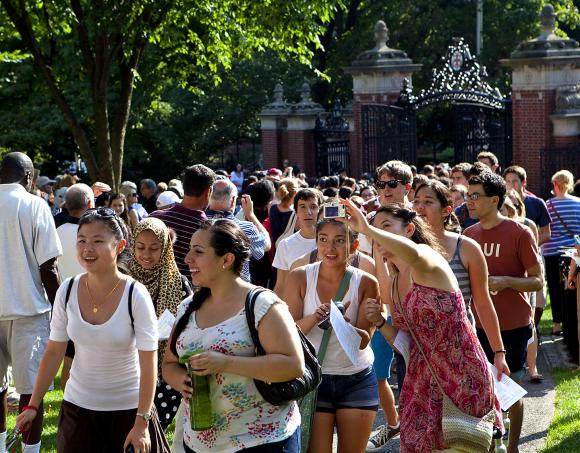PROVIDENCE, R.I. [Brown University] — Brown University President Ruth J. Simmons will officially open the 248th academic year during Opening Convocation, Wednesday, Sept. 7, 2011, at 4 p.m. on the College Green. Mark S. Schlissel, the 11th provost of the University, will deliver the keynote address titled “False Choices,” which will touch on the interdependence of the sciences and the humanities within a liberal education.
The Opening Convocation ceremony, available live online (transcript also online), begins with the traditional procession of incoming students through the Van Wickle Gates onto the College Green. This year, Brown welcomes 1,507 first-year students, 565 new graduate students, 109 new medical students, and 84 transfer students, six of whom are enrolled in the Resumed Undergraduate Education program.
Mark Schlissel
Mark Schlissel became the 11th provost of Brown University on July 1, 2011. He came to Brown from the University of California–Berkeley, where he served as dean of biological sciences in the College of Letters and Science.

Schlissel began his independent research career at the Johns Hopkins University School of Medicine in 1991, where he earned a number of awards and fellowships for his research and for his teaching. He moved to the Department of Molecular and Cell Biology at the University of California–Berkeley in 1999 as associate professor, advancing to full professor in 2002. He taught undergraduate and graduate courses in immunology as well as a large introductory course in biology for life science majors.
Schlissel’s research has focused on the developmental biology of B lymphocytes, the cell type in the immune system that secretes antibodies. His work has led to a detailed understanding of genetic factors involved in the production of antibodies and how mistakes in that process can lead to leukemia and lymphoma. He is the author or co-author of nearly 100 scientific papers.
As an academic administrator, Schlissel began serving as chair of the UC-Berkeley’s graduate admission committee in 2001. He served as vice chair of the department from 2002 to 2007 and was appointed dean of biological sciences in July 2008. Nationally, he has served as member (2002-04) and chair (2004-06) of the Immunobiology Study Section at the National Institutes of Health and currently serves as a member of the Howard Hughes Medical Institute’s Scientific Review Board. Schlissel was elected to the American Society of Clinical Investigators in 1998 and has been a member of the American Association of Immunologists since 1992.
The Class of 2015
A total of 30,944 people applied to be members of Brown’s undergraduate Class of 2015. The University admitted 2,757 students (8.9 percent), yielding a matriculating class of 1,507.
- Gender: 735 men (49%) and 772 women (51%);
- Diversity: 34 percent of the Class of 2015 are students of color;
- First-generation: 16 percent of students are the first in their family to attend college;
- Academic interests: The most popular intended areas of concentration are engineering, biology, international relations, human biology, and neuroscience;
- Geographic area: The Class of 2015 comes from 47 U.S. states and 64 countries. Fifteen percent of students are international. The top foreign countries represented are China, India, Canada, Korea, and Singapore.
The Graduate School
A total of 9,319 students applied to begin master’s and doctoral programs at Brown. The University admitted 1,389 (15%), yielding a matriculating class of 565. Selectivity for Ph.D. programs was 10 percent. Thirty-three percent of incoming graduate students are international. The top foreign countries represented are China, India, Canada, Turkey, and Korea.
The Warren Alpert Medical School
One hundred and nine first-year medical students have begun their studies at the newly renovated medical education building at 222 Richmond St. The Warren Alpert Medical School received 6,231 applications for its M.D. Class of 2015. Nearly half of the new students are entering through the American Medical College Application Service route of admission, while 36 percent are entering the medical school portion of Brown's eight-year Program in Liberal Medical Education, which they entered as high school graduates. Overall, matriculating medical students range in age from 21 to 37 years of age. About 57 percent of incoming students concentrated in physical and life sciences or engineering-related disciplines as undergraduates, while 43 percent majored in the humanities.

